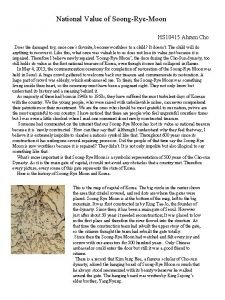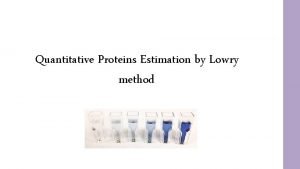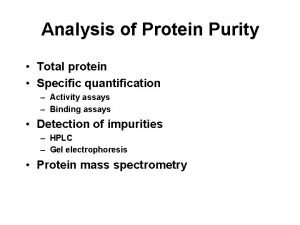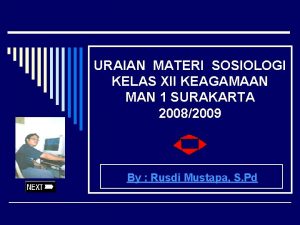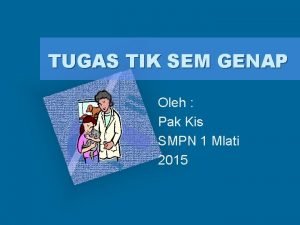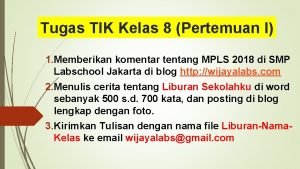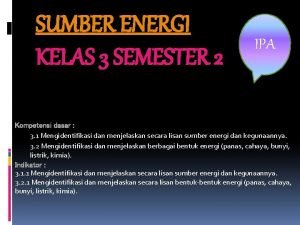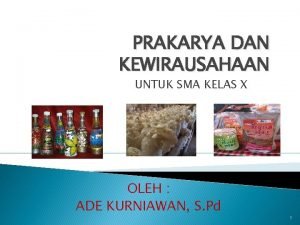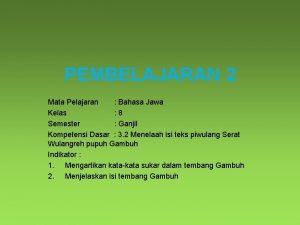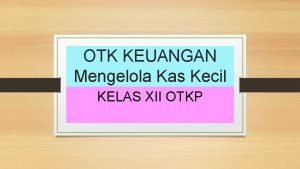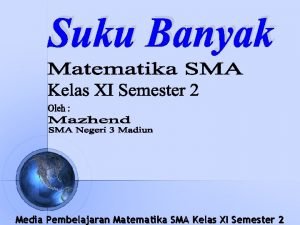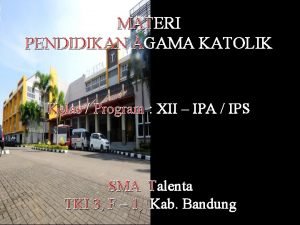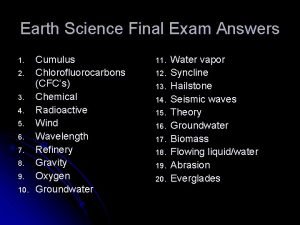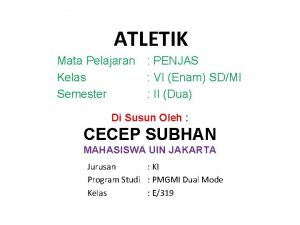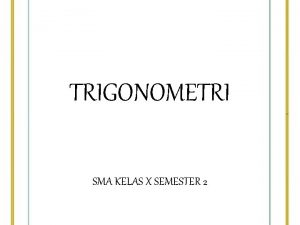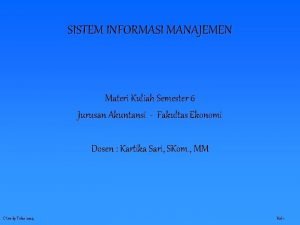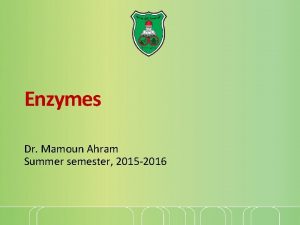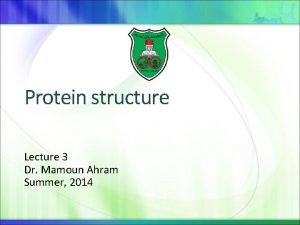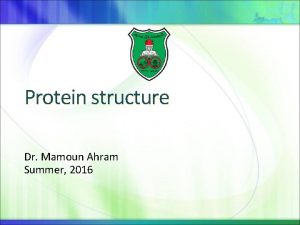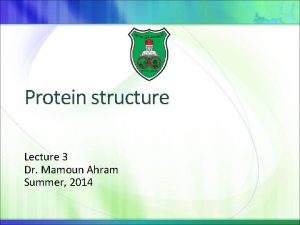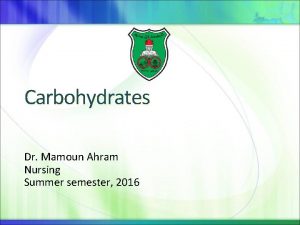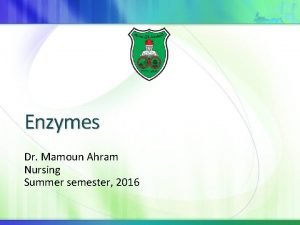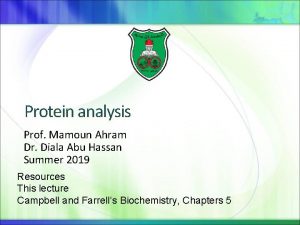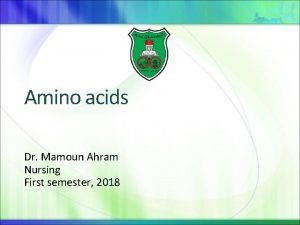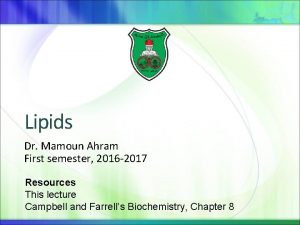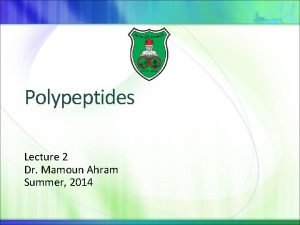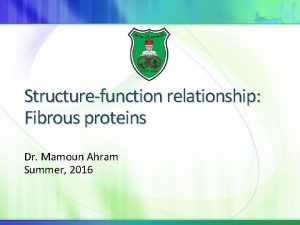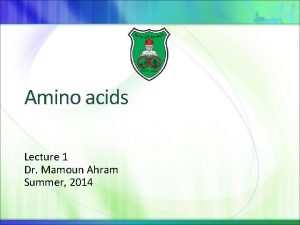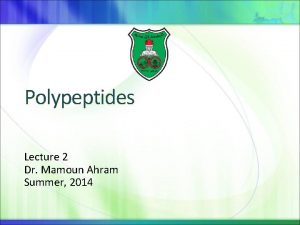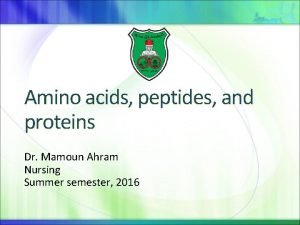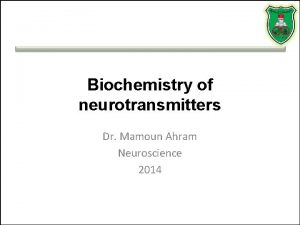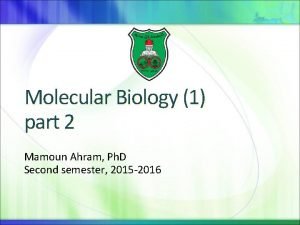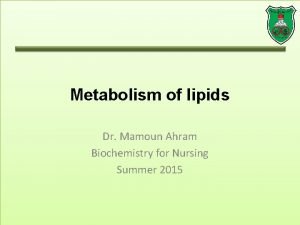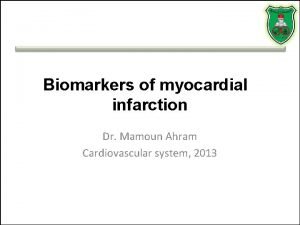Protein analysis Dr Mamoun Ahram Summer semester 2015























































- Slides: 55

Protein analysis Dr. Mamoun Ahram Summer semester, 2015 -2016 Resources This lecture Campbell and Farrell’s Biochemistry, Chapters 5

Sample preparation and processing The first step is homogenization (grinding, Potter–Elvejhem homogenizer, sonication, freezing and thawing, detergents). This is followed by centrifugation.

Sedimentation A particle sediments by centrifugation Sedimentation depends on its mass and shape The sedimentation of a particle is constant and can be defined as a sedimentation coefficient Sedimentation coefficient = 10 -13 S Svedberg The sedimentation of a particle depends on its Mass (direct correlation) Density (direct correlation) Shape (inverse correlation) The density of the solution (inverse correlation)


Example: cell fractionation This treatment separates cell components on the basis of size. In general, the largest units experience the largest centrifugal force and move the most rapidly

Basis of protein separation Proteins can be purified on the basis Solubility Size Charge specific binding affinity

Salting in…salting out Proteins are usually poorly soluble in pure water, but their solubility increases as the ionic strength increases. salting in At high salt concentrations, most proteins become less soluble salting out Why?

Why? When salt like ammonium sulfate is added to a protein solution, some of the water is taken away from the protein to make ion–dipole bonds with the salts. With less water available to hydrate the proteins, they begin to interact with each other through hydrophobic bonds. At a defined amount of ammonium sulfate, a precipitate that contains some proteins forms. These proteins are centrifuged down and discarded. When more salt is added, a different set of proteins, precipitates. And so on.

Uses of salting out Salting out can be used to fractionate proteins

Dialysis Proteins can be separated from small molecules by dialysis through a semipermeable membrane Disadvantage of dialysis 1. Large number of larger proteins will still exist. 2. Smaller proteins of significance are lost.

Chromatography techniques Separation of molecules present in a liquid or gaseous environment (mobile phase) via passing through a column (long tube) that contains an immobile phase (stationary phase) Types: Gel filtration Ion-exchange chromatography Affinity chromatography

Gel-filtration chromatography Separations on the basis of size-exclusion chromatography Molecular sieve chromatography The stationary phase: porous beads Large molecules flow more rapidly and come out first Smaller molecules take a longer time in the column and exit late


Ion-Exchange Chromatography Proteins have different p. I’s (and net charges at various p. H’s)

Cationic-exchange chromatography The beads are negatively -charged Proteins that have a net positive charge will tend to emerge first, followed by those having a higher positive charge density

Elution A positively charged protein bound to such a column can then be eluted (released) by adding increasing the concentration of sodium chloride. Why? because sodium ions compete with positively charged groups on the protein for binding to the column

Anionic-exchange chromatography The beads are positively-charged diethylaminoethyl-cellulose column Negatively charged proteins are separated


Problem You have 5 different proteins (#1, #2, #3, #4, and #5), with different isoelectric points (p. Is) p. I#5 = 2. 3 p. I#4 = 4. 7 p. I#1 = 7. 2 p. I#2 = 9. 1 p. I#3 = 12. 1 Starting the column at p. H 6. 5, the sample is added and then washed to remove unbound molecules. What is the order of protein elution in a Cationic-exchange chromatography? An anionic exchange chromatography?

Affinity Chromatography Affinity: strength of binding between two molecules Affinity chromatography takes advantage of the high affinity of many proteins for specific chemical groups or other proteins (antibodies) Affinity chromatography is most effective when the interaction of the protein and the molecule that is used as the bait (trap) is highly specific


Example The plant protein concanavalin A, which binds to glucose with high affinity, can be purified by passing a protein mixture through a column of beads attached to glucose residues. Concanavalin A, but not other proteins, binds to the beads. The bound concanavalin A can then be released by adding a concentrated solution of glucose. What kind of proteins would a concanavalin A-linked bead separate?

Gel electrophoresis A molecule with a net charge will move in an electric field This phenomenon, termed electrophoresis, offers a powerful means of separating proteins In gel electrophoresis, proteins are separated as they move through a gel, which serves as a molecular sieve http: //course 1. winona. edu/sberg/ANIMTNS/Flash. Animations/SDSgel/s ds. Gel. Advanced. swf http: //sdspagestudy. blogspot. com/2009_10_01_archive. html

The process The most commonly used protein electrophoresis technique is termed SDS polyacrylamide gel electrophoresis (SDS-PAGE) It is performed in a thin, vertical gel The top of the gel consists of wells onto which samples are loaded

Formation of the gel The gel is made of a material known as polyacrylamide, which is formed by the polymerization of acrylamide and crosslinked by methylenebisacrylamide

SDS This technique utilizes a negatively charged detergent (sodium dodecyl sulfate) to denature and solubilize proteins SDS makes proteins have a uniform negative charge

Migration of proteins In this case, when an electrical voltage is applied between the upper and lower ends of the gel, all proteins move in one direction towards the anode (positive) The direction of movement is from top to bottom Whereas smaller molecules move readily through the gel, larger molecules are slower Therefore, proteins are separated based upon size The mixture of proteins is also treated with reducing agents like β-mercaptoethanol or dithiothreitol to reduce disulfide bonds (denaturing condition) Otherwise, non-denaturing condition


Then… Once a gel has been "run", proteins are stained to reveal the positions of the proteins that appear as bands

Electrophoretic analysis of protein purification

Questions Describe the protein’s structure based on the following results of SDS-PAGE: 1. Under non-reducing condition, a protein exists as one 40 -KDa band. Under reducing conditions, the protein exists as two 20 KDa bands. 2. Under non- reducing condition, a protein exists as two bands, 30 KDa and 20 KDa. Under reducing conditions, the protein also exists as two bands, 15 KDa and 10 KDa. 3. Under non- reducing condition, a protein exists as two bands, 40 KDa and 20 KDa. Under reducing conditions, the protein exists as one bands of 20 KDa.

Under non-reducing condition, a protein exists as one 40 -KDa band. Under reducing conditions, the protein exists as two 20 -KDa bands. Non-reducing Reducing 40 KDa 20 KDa

Under non- reducing condition, a protein exists as two bands, 30 KDa and 20 KDa. Under reducing conditions, the protein also exists as two bands, 15 KDa and 10 Kda. Non-reducing Reducing 30 KDa 20 KDa 15 KDa 10 KDa

Under non- reducing condition, a protein exists as two bands, 40 KDa and 20 KDa. Under reducing conditions, the protein exists as one bands of 20 KDa. Non-reducing Reducing 40 KDa 20 KDa

Isoelectric focusing A gel is prepared with a p. H gradient. As proteins migrate through the gel, they encounter regions of different p. H, so the charge on the protein changes. Eventually each protein reaches the point at which it has no net charge—its isoelectric point—and no longer migrates. Each protein remains at the position on the gel corresponding to its p. I, allowing for separation of proteins

p. H 3 + 10 -

Two-dimensional gele electrophoresis (2 D-PAGE) In 2 D-PAGE, proteins are separated by first, isoelectric focusing, then through an SDS-PAGE Thus, it allows protein separation based on both charge and size

p. H 3 + High MW Low MW 10 -

2 D SDS-PAGE animation http: //highered. mcgrawhill. com/sites/0072835125/student_view 0/animations. html#

ELISA Enzyme-linked immunosorbent assay Same concept as immunoblotting but rapid, convenient, and sensitive (less than nanogram (10 -9 g) of a protein) http: //www. genscript. com/gsfiles/flash/protein_a_elisa_pr otocol. swf

ELISA

Protein sequencing is basically the process of knowing the amino sequence of a protein o a peptide. One technique is known as Edman Degradation. This procedure involves a step-by-step cleavage of the Nterminal residue of a peptide, allowing for the identification of each cleaved residue

Procedure This method utilizes phenylisothiocyanate (PITC) to react with the N -terminal residue. The resultant amino acid is hydrolyzed, liberated from the peptide, and identified by chromatographic procedures.

Advantage Since the remainder of the peptide is intact, the entire sequence of reactions can be repeated over and over to obtain the sequences of the peptide The Edman degradation technique does not allow peptides more than 50 residues to be sequenced

Methods It is possible to sequence whole proteins by cleaving them into smaller peptides This is facilitated by three methods: Chemical digestion Endopeptidases Exopeptidases

Chemical digestion The most commonly utilized chemical reagent that cleaves peptide bonds by recognition of specific amino acid residues is cyanogen bromide (CNBr) This reagent causes specific cleavage at the C-terminal side of methionine residues A protein that has 10 methionine residues will usually yield 11 peptides on cleavage with CNBr

Endopeptidases These are enzymes that cleave at specific sites within the primary sequence of proteins The resultant smaller peptides can be chromatographically separated and subjected to Edman degradation sequencing reactions

Example Trypsin cleaves polypeptide chains on the carboxyl side of arginine and lysine residues A protein that contains 9 lysine and 7 arginine residues will usually yield 17 peptides on digestion with trypsin Another example

Other examples Enzyme Trypsin Chymotrypsin Elastase Pepsin Specificity peptide bond C-terminal to R, K, but not if next to P peptide bond C-terminal to F, Y, W but not if next to P peptide bond C-terminal to A, G, S, V, but not if next to P peptide bond N-terminal to L, F, W, Y, but when next to P

Exopeptidases These are enzymes that cleave amino acids starting at the end of the peptide There are two types: aminopeptidases that cleave at the N-terminus carboxypeptidases that cleave at the C-terminus

Homework Do questions 49 and 54

Protein sequencing – prediction from DNA & RNA If the sequence of the gene is known, this is very easy If the sequence of the gene is unknown (newly isolated proteins)? Sequence a short segment, complementary RNA, isolate m. RNA, PCR, gene sequencing

Crystallography X-ray crystallography is used to determine three-dimensional structure of proteins. A protein must first be turned into a crystal before being exposed to x-rays, which are scattered by the electrons of the molecule http: //www. dnatube. com/video/279/Protein-Structure-Revealed-xraycrystallography

Nuclear magnetic resonance (NMR) spectroscopy reveals the structure and dynamics of proteins in solution (not crystals) This is important with protein binding to other molecules like enzymes to their substrates, receptors to their ligands, etc.

Myoglobin Hemoglobin Myoglobin and Hemoglobin
 Mamoun ahram
Mamoun ahram Mamoun ahram
Mamoun ahram Ahram cho
Ahram cho Protein pump vs protein channel
Protein pump vs protein channel Protein-protein docking
Protein-protein docking Quantitative analysis of protein by lowry method
Quantitative analysis of protein by lowry method Protein purity analysis
Protein purity analysis Summer's reading שאלות
Summer's reading שאלות Nsa cooperative education program
Nsa cooperative education program Antonio vivaldi the four seasons summer
Antonio vivaldi the four seasons summer Materi sosiologi kelas 12 semester 2
Materi sosiologi kelas 12 semester 2 Materi desain grafis kelas 10 semester 2
Materi desain grafis kelas 10 semester 2 Fall semester exam review us history
Fall semester exam review us history Tugas tik kelas 9 semester 2
Tugas tik kelas 9 semester 2 Materi tik kelas 8 semester 2
Materi tik kelas 8 semester 2 Chemistry semester 2 review unit 12 thermochemistry
Chemistry semester 2 review unit 12 thermochemistry Terompet gitar dan suling merupakan contoh sumber energi
Terompet gitar dan suling merupakan contoh sumber energi Negara yang ditunjukkan oleh anak panah beribukota di
Negara yang ditunjukkan oleh anak panah beribukota di Wharton semester in san francisco
Wharton semester in san francisco English 4 semester 2 exam
English 4 semester 2 exam English 11 semester exam
English 11 semester exam Pointing
Pointing Materi segitiga smp kelas 7 semester 2
Materi segitiga smp kelas 7 semester 2 Rangkuman pelajaran ips kelas 7
Rangkuman pelajaran ips kelas 7 Ppt prakarya dan kewirausahaan kelas xi semester 1
Ppt prakarya dan kewirausahaan kelas xi semester 1 Contoh nilai median
Contoh nilai median Materi mice kelas 11 semester 2
Materi mice kelas 11 semester 2 Relevansi tembang gambuh
Relevansi tembang gambuh Modul otk keuangan kelas 12
Modul otk keuangan kelas 12 Fungsi pembagian laba adalah
Fungsi pembagian laba adalah Materi matematika kelas 11 semester 2
Materi matematika kelas 11 semester 2 Materi agama katolik kelas 12 semester 1
Materi agama katolik kelas 12 semester 1 Bab 1 hidup beriman
Bab 1 hidup beriman Physics semester 1 review
Physics semester 1 review Bagaimana cara menamai sudut
Bagaimana cara menamai sudut World history semester 2 final review packet
World history semester 2 final review packet World history fall semester exam review
World history fall semester exam review Final exam environmental science
Final exam environmental science Earth science final exam answers
Earth science final exam answers Forudsætningskrav sygeplejerske 1 semester
Forudsætningskrav sygeplejerske 1 semester Semester vs trimester
Semester vs trimester Materi pjok kelas 6 semester 1 atletik
Materi pjok kelas 6 semester 1 atletik Us history final semester 2 review
Us history final semester 2 review Final exam review algebra 1
Final exam review algebra 1 Unsw academic calender
Unsw academic calender Uf law semester in practice
Uf law semester in practice Tugas prakarya kelas 11
Tugas prakarya kelas 11 Trigonometri kelas 10 semester 2
Trigonometri kelas 10 semester 2 Kompetensi dasar fisika kelas 11
Kompetensi dasar fisika kelas 11 Spanish final exam review packet answer key
Spanish final exam review packet answer key Materi sistem informasi manajemen semester 4
Materi sistem informasi manajemen semester 4 Pengantar teknologi informasi semester 1
Pengantar teknologi informasi semester 1 Senior high school subjects (per semester)
Senior high school subjects (per semester) American literature semester 1 final
American literature semester 1 final Remainder of the semester
Remainder of the semester Mary is trying hard in school this semester her father said
Mary is trying hard in school this semester her father said


